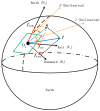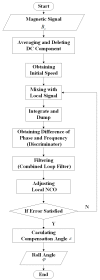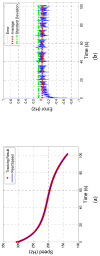Real-Time Estimation for Roll Angle of Spinning Projectile Based on Phase-Locked Loop on Signals from Single-Axis Magnetometer
- PMID: 30781663
- PMCID: PMC6412822
- DOI: 10.3390/s19040839
Real-Time Estimation for Roll Angle of Spinning Projectile Based on Phase-Locked Loop on Signals from Single-Axis Magnetometer
Abstract
As roll angle measurement is essential for two-dimensional course correction fuze (2-D CCF) technology, a real-time estimation of roll angle of spinning projectile by single-axis magnetometer is studied. Based on the measurement model, a second-order frequency-locked loop (FLL)-assisted third-order phase-locked loop (PLL) is designed to obtain rolling information from magnetic signals, which is less dependent on the amplitude and able to reduce effect from geomagnetic blind area. Method of parameters optimization of tracking loop is discussed in the circumstance of different speed and it is verified by six degrees of freedom (six degrees of freedom (DoF)) trajectory. Also, the measurement error is analyzed to improve the accuracy of designed system. At last, experiments on rotary table are carried out to validate the proposed method indicating the designed system is able to track both phase and speed accurately and stably. The standard deviation (SD) of phase error is no more than 3°.
Keywords: 2-D CCF; FLL-assisted PLL; magnetic sensor; roll angle measurement; spinning projectile.
Conflict of interest statement
The authors declare no conflicts of interest.
Figures
























References
-
- Carlucci D., Pellen R., Pritchard J., Demassi W. Defense Technical Information Center; Fort Belvoir, VA, USA: 2010. Smart Projectiles: Design Guidelines and Development Process Keys to Success.
-
- Mahajan C., Motghare V. Smart Munitions. Defence Sci J. 2010;3:159–163. doi: 10.14429/dsj.60.334. - DOI
-
- Yuan W., Zhang J.Q., Yang F. Study on Stable Scanning of Terminal Sensitivity Projectile and Hardware-in-the-Loop Simulation System. Pure Appl. Math. J. 2015;4:24–27. doi: 10.11648/j.pamj.s.2015040501.15. - DOI
-
- Daso D.A. Weapons of Choice: The Development of Precision Guided Munitions (Review) Technol. Culture. 2007;49:252–254. doi: 10.1353/tech.2008.0021. - DOI
-
- Wang Z.F., Wang H. Target Location of Loitering Munitions Based on Image Matching; Proceedings of the 2011 6th IEEE Conference on Industrial Electronics and Applications; Beijing, China. 21–23 June 2011; pp. 606–609. - DOI
LinkOut - more resources
Full Text Sources
Research Materials

